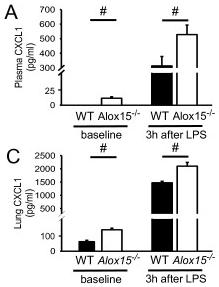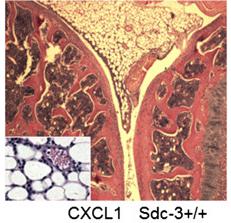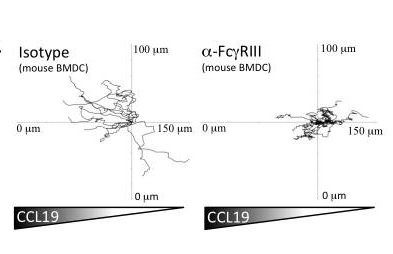Mouse GRO-alpha (CXCL1)Recombinant
Category: Recombinant Mouse Cytokines$70.00 – $2,700.00
Description
Accession
P12850
Source
Optimized DNA sequence encoding mouse GRO alpha mature chain was expressed in Escherichia Coli.
Molecular weight
Native mouse CXCL1/GRO-alpha is generated by the proteolytic removal of the signal peptide and propeptide. The molecule has a calculated molecular mass of approximately 8 kDa. Recombinant mouse CXCL1/GRO-a is a monomer protein consisting of 72 amino acid residue subunits, and migrates as an approximately 8 kDa protein under non-reducing and reducing conditions in SDS-PAGE.
Purity
>97%, as determined by SDS-PAGE and HPLC
Biological Activity
Determined by theability to chemoattract human neutrophils using a concentration range of.0-50.0 ng/ml.
Protein Sequence
MIPATRSLLC AALLLLATSR LATGAPIANE LRCQCLQTMA GIHLKNIQSL KVLPSGPHCT QTEVIATLKN GREACLDPEA PLVQKIVQKM LKGVPK
Endotoxin
Endotoxin content was assayed using a LAL gel clot method. Endotoxin level was found to be less than 0.1 ng/µg(1EU/µg).
Presentation
Recombinant mouse GRO-alpha/CXCL1was lyophilized from a 0.2μm filtered PBS pH.4.
Reconstitution
A quick spin of the vial followed by reconstitution in distilled water to a concentration not less than 0.1 mg/mL. This solution can then be diluted into other buffers.
Storage
The lyophilized protein is stable for at least years from date of receipt at -20° C. Upon reconstitution, this cytokine can be stored in working aliquots at2° -8° C for one month, or at -20° C for six months, with a carrier protein without detectable loss of activity. Avoid repeated freeze/thaw cycles.
Usage
This cytokine product is for research purposes only.It may not be used for therapeutics or diagnostic purposes.
Biological Process
Molecular function
Molecular function
Methods
Leukocyte adhesion in CXCL1-stimulated cremaster muscle venules.
- The number of adherent cells (mean ± SEM) was assessed in exteriorized cremaster muscle venules of RAGE-/- mice (10 venules in 6 mice), Icam1mice (11 venules in 5 mice), untreated (12 venules in 7 mice), anti-LFA-1 antibody (10 venules in 4 mice) or isotype antibody (9 venules in 3 mice) treated wild type mice before and five minutes after systemic injection of CXCL1 (keratinocyte-derived chemokine, KC; 600 ng/mouse).
Leukocyte adhesion (number of adherent cells/mm2) in mouse cremaster muscle venules and leukocyte transmigration (perivascular neutrophils/mm2 surface area) in cremaster muscle whole mounts in response to glucose during trauma-induced inflammation.
- To dissect the role of the chemokine pathway in this model, WT mice were either pretreated with 4 μg PTx 3 h prior to cremaster exteriorization and glucose stimulation or coinjected with 600 ng CXCL1 and glucose and compared to injection of normal saline.
Flow Cytometric Analysis
- For flow cytometric analysis of surface markers and intracellular cytokines, enriched C4+ T cells, and single-cell suspensions of lungs were stained with optimal concentrations of the following specific antibodies against surface molecules and intracellular cytokines: C8 α-V450, C4-V500, C11c-FITC, C62L-APC, Gr-1-APC, IFNγ-APC from , , , , and MHCII(I-A/I-E)-eFluor780 from eBioscience, C44-FITC, and IFNγ-PE fromand IL-22-PE from& .
- Fluorescence intensity was measured by using a FacsCantoII® flow cytometer equipped with a 405 nm, 488 nm and 633 nm laser.
- Analysis was performed utilizing the FCSExpress4 program (DeNovo™ Software) gated on leukocytes identified by the forward-scatter/side-scatter profile and further characterization as specified in the figures.
In vivo experiments
- For adoptive transfer studies, classical monocytes were isolated from BM by FACS sorting using antibodies to CD45, CD115, and Gr1.
- After labelling the monocytes with CFSE, 106 cells were adoptively transferred by tail vein injection to
. - Twenty-four hours after transfer, aortas and hearts of recipient mice were collected for further analysis.
- For monocyte mobilization studies, rmCXCL1/KC was injected i.v.
- at 40 µg/kg.
- After 1 h, blood was drawn and mice were sacrificed to harvest bones and spleens.
- Serum CXCL1 in mice was neutralized by daily administration of 5 µg of anti-CXCL1 antibody (clone 124014) or IgG isotype control (clone 54447, both& ) for 1 week and for 3 consecutive weeks every other day.
Elimination of 12/15-LO activity alters chemokine homeostasis.
- CXCL1 and CXCL2 concentrations in the plasma was measured in WT mice (black bars) and Alox15mice (white bars) under baseline conditions and 3 h after LPS inhalation (n = 3 to 4).






